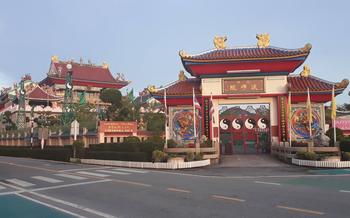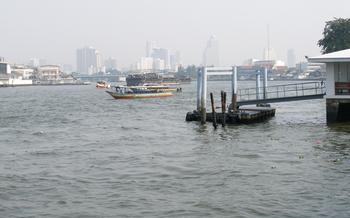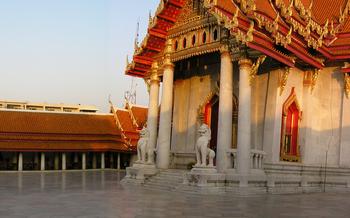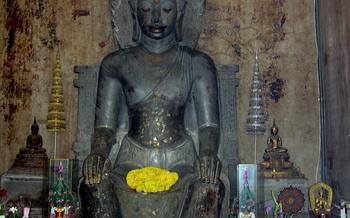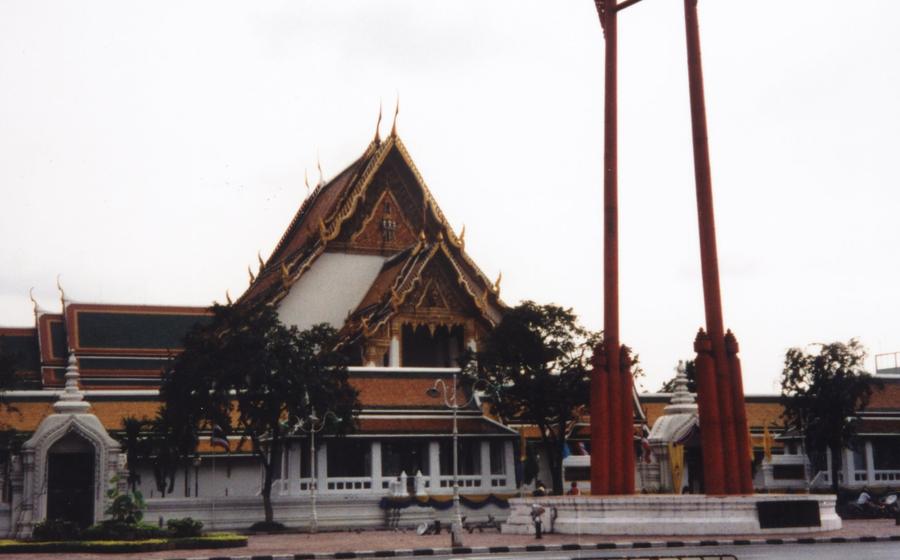
Wat Suthat and The Giant Swing
- Wat Suthat: A Journey Through History and Spirituality
- The Giant Swing
- Exploring the Temple Grounds
- Admiring the Architectural Details
- Exploring the History and Legends
- Taking a Guided Tour
- Learning About Thai Buddhism
- Photography and Capturing the Beauty
- Combining with Other Attractions
- Shopping for Souvenirs
- Enjoying Local Delicacies:
- Insider Tip: Unveiling Hidden Gems and Experiencing Serenity
Wat Suthat: A Journey Through History and Spirituality
In the heart of Bangkok's vibrant cityscape, Wat Suthat Thepwararam stands as a testament to the intricate tapestry of Thai history, religion, and cultural heritage. Founded in 1807 by King Rama I, this majestic temple holds a profound significance in the spiritual landscape of Thailand. As you step through the temple gates, you'll be greeted by a tranquil sanctuary adorned with opulent architecture, intricate murals, and towering stupas, each telling a unique story from Thailand's rich past.
The temple's central highlight is the grand ubosot (ordination hall), where intricate murals depict scenes from the life of Buddha, narrating his journey from birth to enlightenment. The walls are adorned with vibrant paintings, each stroke imbued with deep religious symbolism and cultural motifs. Among the notable Buddha images enshrined within the ubosot is the revered Phra Si Sakayamuni, a colossal bronze Buddha statue that exudes an aura of serenity and grandeur.
Wat Suthat is not merely a place of worship but also a repository of Thai cultural heritage. Its architectural design showcases the pinnacle of Thai craftsmanship, blending traditional elements with exquisite embellishments. The towering stupas, intricate carvings, and delicate frescoes are a testament to the skill and artistry of Thai artisans. The temple's grounds are meticulously landscaped, with lush gardens, fragrant flowers, and serene ponds, creating a harmonious balance between nature and spirituality.
The Giant Swing
The Giant Swing, known as Sao Ching Cha in Thai, stands as a testament to the rich cultural heritage of Thailand. Once used for a daring ritual during the annual Brahmin ceremony, the swing is an iconic symbol of Bangkok's religious and cultural traditions.
Constructed in the 18th century during the reign of King Rama I, the Giant Swing was initially located near the Grand Palace. It was later relocated to its current site in front of Wat Suthat in the 1920s due to safety concerns. The swing is an impressive structure, standing at 21 meters tall and made entirely of teak wood. Its intricate carvings and ornate decorations showcase the exceptional craftsmanship of Thai artisans.
In the past, the Giant Swing was used for a ritual called the "Swinging Ceremony," which was held during the annual Brahmin festival of Triyampawai. During the ceremony, young men would take turns swinging on the giant swing, reaching heights of up to 25 meters. The ritual was believed to bring good luck and prosperity to the kingdom.
Currently, the Giant Swing is no longer used for the swinging ceremony, but it remains a significant cultural landmark in Bangkok. It attracts visitors from around the world who come to admire its unique architecture and learn about its historical significance.
Exploring the Temple Grounds
Beyond the main temple building, the sprawling grounds of Wat Suthat offer a tranquil haven for meditation and reflection. Wander through the serene courtyards, adorned with lush greenery, colorful flowers, and intricate sculptures. Discover hidden nooks and quiet corners where you can sit in contemplation, soak in the peaceful atmosphere, and find solace from the bustling city outside.
Admire the various structures and monuments scattered throughout the grounds, each with its own unique significance. Spot the towering chedis, gleaming stupas, and elegant salas, which serve as meditation halls and places to rest and contemplate. Observe the intricate bas-reliefs and murals that adorn the walls, depicting scenes from Buddhist mythology and Thai folklore.
Take a moment to marvel at the magnificent ordination hall, known as the Ubosot, which houses the temple's most sacred Buddha images. Its ornate facade, intricate carvings, and colorful murals showcase the exquisite craftsmanship of Thai artisans. While in the Ubosot, pay homage to the revered Buddha statues and immerse yourself in the spiritual atmosphere that permeates the space.
Admiring the Architectural Details
Wat Suthat and the Giant Swing showcase the exquisite craftsmanship and artistry of Thai temple architecture. Admire the intricate carvings that adorn every corner of the temple, from the majestic stupas to the delicate window frames. Each element holds religious significance, symbolizing Buddhist teachings and the cosmos.
The gleaming white chedis, or stupas, rise majestically towards the sky, representing the Buddha's journey to enlightenment. Look closely to discover intricate bas-reliefs depicting scenes from the Buddha's life and teachings. These bas-reliefs are a testament to the skill and patience of the artisans who created them.
The intricate carvings on the temple walls and pillars tell stories of mythology and morality. Mythical creatures like garudas, nāgas, and singha guard the temple, symbolizing protection and strength. Floral motifs and geometric patterns add a touch of elegance and beauty to the temple's design.
As you explore the temple grounds, take time to appreciate the harmonious blend of architectural elements. The towering spires, graceful curves, and delicate ornamentation create a visually stunning masterpiece that reflects the deep-rooted spiritual and artistic traditions of Thailand.
Exploring the History and Legends
Wat Suthat and the Giant Swing are steeped in a rich tapestry of myths, legends, and historical significance. According to local folklore, the temple was built to honor the Hindu god Indra, who was believed to have descended from heaven on a giant swing. This legend is depicted in the elaborate carvings on the base of the swing, which showcase celestial beings and mythical creatures.
Throughout history, the temple has witnessed significant events and been associated with influential figures. It served as a royal temple during the Ayutthaya Kingdom and was a popular pilgrimage site for the Thai monarchy. The temple's impressive architecture and grandeur attracted the attention of foreign visitors, including the French ambassador Simon de La Loubère, who described it as one of the most beautiful temples in Siam.
Over the centuries, Wat Suthat has undergone renovations and expansions, reflecting the evolving architectural styles and beliefs of different eras. The temple's current form showcases a blend of traditional Thai and European influences, a testament to its rich history and cultural significance.
Taking a Guided Tour
Enhance your visit to Wat Suthat and the Giant Swing by joining a guided tour. Led by knowledgeable and passionate guides, these tours provide an immersive and educational experience, delving deep into the history, architecture, and cultural significance of the temple complex.
Professional guides bring the temple's stories to life, sharing historical anecdotes, myths, and legends associated with its founding and evolution. They offer insights into the symbolism and religious significance of the intricate carvings, murals, and architectural features, helping you appreciate the temple's beauty and craftsmanship.
Guided tours can be tailored to specific interests, whether you're passionate about history, architecture, or religion. Whether you're a first-time visitor or a seasoned traveler, a guided tour will enrich your experience and provide a deeper understanding of this iconic Bangkok landmark.
Learning About Thai Buddhism
Wat Suthat is not only a stunning architectural marvel but also a sacred site where visitors can delve into the depths of Thai Buddhism. Buddhism, the predominant religion in Thailand, holds a profound significance in shaping the country's culture, beliefs, and way of life. Within the temple grounds, visitors can observe Buddhist rituals and ceremonies, such as the daily chanting of prayers by the resident monks. Guided tours often provide insightful explanations of these rituals, allowing visitors to gain a deeper understanding of the teachings and practices of Buddhism. Whether you're a devout Buddhist or simply curious about this ancient religion, Wat Suthat offers a unique opportunity to immerse yourself in the spiritual essence of Thailand and gain a newfound appreciation for the role of Buddhism in Thai society.
Photography and Capturing the Beauty
The Wat Suthat and the Giant Swing offer a captivating spectacle for photography enthusiasts. The temple's intricate architecture, vibrant colors, and serene atmosphere create a picturesque backdrop for capturing stunning images. To make the most of your photography experience, consider the following tips:
-
Best Angles and Lighting: Position yourself at strategic angles to capture the temple's grandeur. Take advantage of the morning or late afternoon light for soft, warm tones that enhance the temple's beauty.
-
Respecting the Sanctity: While taking photos, remember to be respectful of the temple's sacred nature. Avoid using flash photography, which can be disruptive to worshippers and damage delicate artifacts.
-
Sharing Your Photos: Share your captured memories with the world! Your photos can help promote the beauty of Thai cultural heritage and inspire others to explore this magnificent temple.
-
Unique Perspectives: Explore the lesser-known areas of the temple complex to discover hidden gems and unique perspectives. These secluded spots often offer tranquil moments and stunning compositions.
Combining with Other Attractions
Wat Suthat and the Giant Swing are located in a vibrant neighborhood surrounded by several other attractions that offer a comprehensive glimpse into Bangkok's rich history and culture. To make the most of your visit, consider combining your temple exploration with other nearby destinations.
Start by visiting the Grand Palace and the Temple of the Emerald Buddha, just a short walk away. Marvel at the stunning architecture, intricate murals, and the sacred Emerald Buddha, a revered symbol of Thai monarchy and Buddhism.
Next, head to the Khao San Road, a bustling backpacker hub known for its vibrant nightlife, street food, and shopping. Immerse yourself in the energetic atmosphere, sample delicious local delicacies, and pick up souvenirs from the many stalls and shops.
For a unique cultural experience, visit the National Museum Bangkok, which houses an extensive collection of Thai art and artifacts. Learn about the country's fascinating history, admire traditional Thai costumes, and see ancient Buddha images and sculptures.
To escape the hustle and bustle of the city, take a leisurely boat ride along the Chao Phraya River. Enjoy stunning views of Bangkok's skyline, pass by iconic landmarks, and visit the Wat Arun, the Temple of Dawn, with its distinctive prang-style spires.
By combining your visit to Wat Suthat and the Giant Swing with these other attractions, you'll gain a deeper appreciation for Bangkok's cultural and historical treasures, creating a well-rounded and memorable travel experience.
Shopping for Souvenirs
As you wander through the alleys around Wat Suthat, you'll stumble upon a vibrant tapestry of local markets and shops, enticing you to delve into the world of Thai craftsmanship. These humble stalls and boutiques showcase an array of souvenirs, each piece imbued with the essence of Thai culture and artistry.
Support local artisans by purchasing unique and intricate handicrafts that reflect Thailand's rich heritage. From hand-painted silk scarves and delicate silver jewelry to intricately carved wooden sculptures and aromatic candles, the choices are endless.
Embrace the art of bargaining, a customary practice in Thai markets. Engage in friendly negotiations with the vendors, showcasing your charm and wit to secure the best prices. Remember, bargaining is not just about getting a good deal; it's also a way to connect with the locals and experience the vibrant atmosphere of the market.
As you sift through the treasures, keep an eye out for authentic items that capture the essence of Thailand. Whether it's a handwoven bamboo basket, a traditional ceramic bowl, or a colorful tuk-tuk figurine, these souvenirs will serve as tangible reminders of your journey through the Kingdom of Smiles.
Take home a piece of Thai culture and craftsmanship, a memento that will transport you back to the sights, sounds, and aromas of Wat Suthat and the bustling streets of Bangkok.
Enjoying Local Delicacies:
When visiting Wat Suthat and the Giant Swing, take the opportunity to explore the vibrant food scene in the surrounding area. Indulge in authentic Thai flavors by trying traditional street food and local delicacies. Vendors line the streets, offering a variety of mouthwatering dishes, from fragrant curries and noodle soups to fresh tropical fruits and sweet desserts.
Don't miss the chance to sample some of Thailand's most famous culinary delights, such as pad thai, a stir-fried rice noodle dish with vegetables, meat, and a tangy sauce; tom yum goon, a spicy and sour soup with shrimp; and mango sticky rice, a sweet and savory dessert made with ripe mangoes, sticky rice, and coconut milk.
Exploring the local markets and shops near the temple is a great way to find unique and authentic souvenirs and handicrafts. You can bargain for the best prices and support local artisans who create beautiful items using traditional techniques. From intricate wood carvings and colorful fabrics to handmade jewelry and pottery, there's something for everyone.
Whether you're looking for a quick bite or a leisurely meal, the area around Wat Suthat and the Giant Swing offers a diverse range of culinary experiences. Discover hidden gems and popular eateries among locals, and savor the delicious flavors that make Thai cuisine so beloved around the world.
Insider Tip: Unveiling Hidden Gems and Experiencing Serenity
Exploring the Unexplored: Venture beyond the main tourist areas of the temple complex to discover hidden corners and serene spots. Explore the smaller shrines, secluded gardens, and tranquil courtyards that offer a glimpse into the temple's peaceful and spiritual essence.
Avoiding Crowds: To fully appreciate the temple's serene atmosphere, consider visiting during non-peak hours or on weekdays. This allows you to avoid the crowds and immerse yourself in the temple's tranquility without distractions.
Engaging with the Monks: Engage with the friendly and knowledgeable monks who reside at the temple. Ask questions about their daily lives, the temple's history, and the teachings of Buddhism. This interaction offers a deeper understanding of the temple's spiritual significance and the monks' role in preserving Thai culture.
Early Morning or Late Afternoon Serenity: Experience the temple's serene atmosphere at its peak by visiting in the early morning or late afternoon. During these times, the temple is bathed in a soft, golden light, creating a magical and tranquil ambiance that enhances the spiritual experience.


